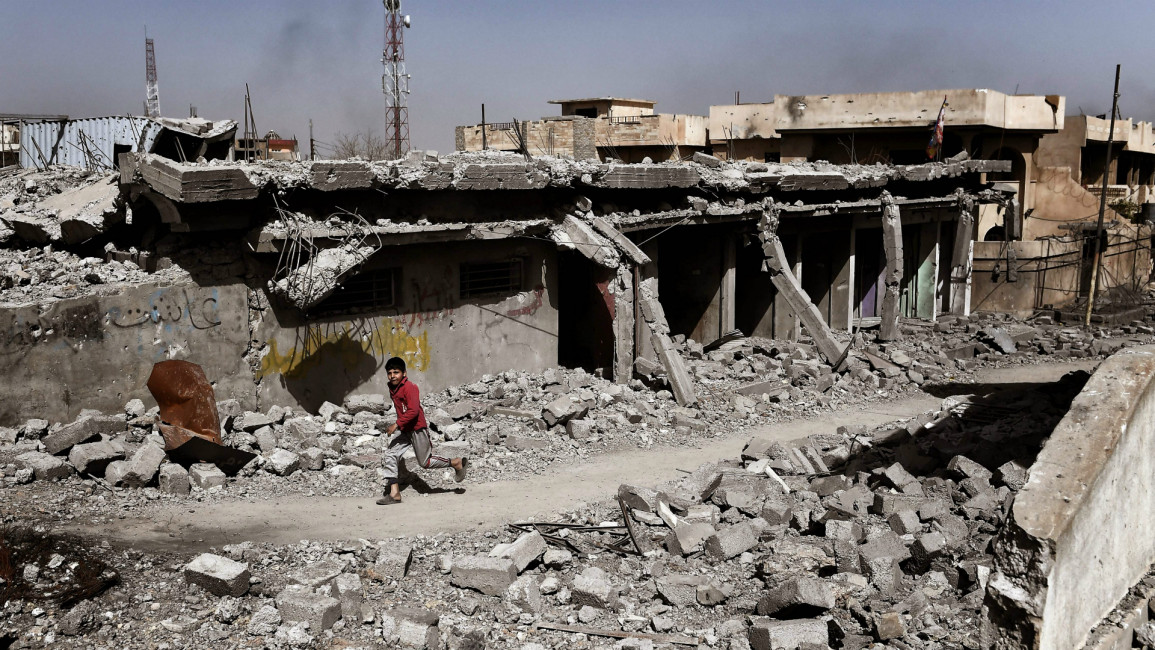#MosulOps: Half the city destroyed, infrastructure in ruins
Destruction in the city overall has reached 60 percent, comprising around 80 percent of the infrastructure, including bridges and water and electricity facilities.
Meanwhile, a large number of civilian causalities remain trapped under the rubble.
Local sources told The New Arab that "Since the start of the battle to recapture Mosul in October, more than 16,000 people have been killed or injured".
The smell of rotting bodies has forced Captain Firas Ali and his comrades, to cover their noses with a mask while in combat.
"The smell is coming from the bodies of dead civilians still buried under the rubble. The number of IS militant bodies is fewer as they are being transferred to another site for identification," Ali told The New Arab.
 |
Five bridges on the Tigris River were ruined and about 55 percent of the city's roads, including the drainage system, were destroyed |  |
Civilian infrastructure in ruins
In Baghdad, sources close to the government said a report has been handed to the government highlighting "the extent of the damage to health facilities in Mosul, which include the complete destruction of all six [government] hospitals as well as 32 medical centres."
The New Arab has not authenticated the findings.
The report also stated that "five bridges on the Tigris River were ruined and about 55 percent of the city's roads, including the drainage system, were destroyed.
|
|
|
|
"Three power stations, seven water facilities, around 200 schools and five colleges were also damaged, as well as the buildings of Mosul University."
In January, the Iraqi government approved 27 UN-sponsored projects for the reconstruction of Mosul's liberated areas, but is yet to determine a time frame to start the work.
Last weekend, Iraqi forces surrounded western Mosul after capturing the last road into the enclave of about 40 square kilometres (15 square miles), comprising some of the city's most densely built districts.
In the month since the assault on the west began, troops have retaken the city's airport, a sprawling military complex, the main government compound and a ribbon of neighbourhoods on the southwest side of Mosul.
The offensive is being waged from three directions with two divisions of Special Forces and a force of federal police advancing along the Tigris River, which divides the city into its western and eastern half.
Meanwhile, residents trapped in western Mosul face dwindling supplies of food and fuel. Around 50,000 civilians have fled in the past four weeks, according to the UN.
IS overran large areas north and west of Baghdad in 2014, but Iraqi forces backed by US-led air strikes and other support have since retaken most of the territory they lost.
Iraqi forces launched a major operation to retake the entire Mosul city in October, recapturing the eastern side before setting their sights on the smaller but more densely-populated west.
Mosul fell to the Islamic State in a wide blitz in the summer of 2014, shortly before the group declared a 'caliphate' from the city.
During the jihadist advance, the Iraqi army abandoned its positions, allowing the extremists to seize large caches of weapons as well as heavy military hardware, including armoured vehicles.


![President Pezeshkian has denounced Israel's attacks on Lebanon [Getty]](/sites/default/files/styles/image_684x385/public/2173482924.jpeg?h=a5f2f23a&itok=q3evVtko)



 Follow the Middle East's top stories in English at The New Arab on Google News
Follow the Middle East's top stories in English at The New Arab on Google News


